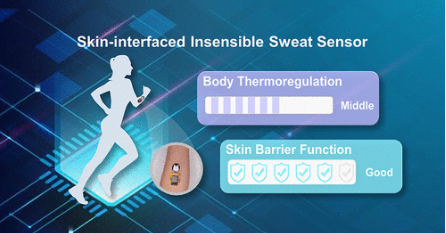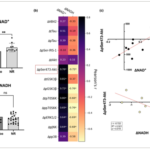2023-02-22 ペンシルベニア州立大学(PennState)
◆このセンサーは、James L. Henderson, Jr.記念工学部准教授のHuanyu “Larry” Chengによって開発された。James L. Henderson Jr. Memorial Associate Professor of Engineering Science and Mechanics)が開発したセンサーが、『ACS Nano』誌に掲載されました。
◆感覚的発汗(液体汗)とは、激しい運動時などに人が感じることのできる汗のことです。ウェアラブルセンサーは、このタイプの汗を連続的かつ非侵襲的に追跡することができます。一方、「不感蒸泄」と呼ばれる汗は、水蒸気とは異なります。低強度の運動時や休息時に分泌され、皮膚から水だけが失われるもので、Chengによれば、その測定は困難であるという。
◆Chengは、感知できない汗から蒸気を測定するために、超疎水性汗センサーのプロトタイプを開発しました。多孔質基材に高吸水性ハイドロゲルを複合化し、2枚の超撥水性繊維で挟んだこの素材は、汗の蒸気を透過させる一方で、センサーが外部の顕性汗の水滴の影響を受けないようにするものである。このセンサーは、柔軟性のある無線通信モジュールや電源モジュールと一体化し、体のさまざまな場所の発汗量を継続的にモニターすることができます。
<関連情報>
- https://www.psu.edu/news/engineering/story/superhydrophobic-biosensor-could-measure-sweat-vapors-body/
- https://pubs.acs.org/doi/full/10.1021/acsnano.2c11267
体温調節と皮膚バリア機能を評価するための皮膚に埋め込まれた超疎水性不感蒸発センサー Skin-Interfaced Superhydrophobic Insensible Sweat Sensors for Evaluating Body Thermoregulation and Skin Barrier Functions
Yangchengyi Liu, Xiaofeng Li, Hanlin Yang, Ping Zhang, Peihe Wang, Yi Sun, Fengzhen Yang, Weiyi Liu, Yujing Li, Yao Tian, Shun Qian, Shangda Chen, Huanyu Cheng, and Xiufeng Wang
ACS Nano Published:February 6, 2023
DOI:https://doi.org/10.1021/acsnano.2c11267

Abstract
Monitoring sweat rate is vital for estimating sweat loss and accurately measuring biomarkers of interest. Although various optical or electrical sensors have been developed to monitor the sensible sweat rate, the quantification of the insensible sweat rate that is directly related to body thermoregulation and skin barrier functions still remains a challenge. This work introduces a superhydrophobic sweat sensor based on a polyacrylate sodium/MXene composite sandwiched between two superhydrophobic textile layers to continuously measure sweat vapor from insensible sweat with high sensitivity and rapid response. The superhydrophobic textile on a holey thin substrate with reduced stiffness and excellent breathability allows the permeation of sweat vapor, while preventing the sensor from being affected by the external water droplets and internal sensible sweat. Integrating the insensible sweat sensor with a flexible wireless communication and powering module further yields a standalone sensing system to continuously monitor insensible sweat rates at different body locations for diverse application scenarios. Proof-of-concept demonstrations on human subjects showcase the feasibility to continuously evaluate the body’s thermoregulation and skin barrier functions for the assessment of thermal comfort, disease conditions, and nervous system activity. The results presented in this work also provide a low-cost device platform to detect other health-relevant biomarkers in the sweat (vapor) as the next-generation sweat sensor for smart healthcare and personalized medicine.


